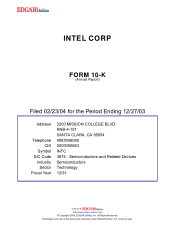Intel 2003 Annual Report Download - page 11
Download and view the complete annual report
Please find page 11 of the 2003 Intel annual report below. You can navigate through the pages in the report by either clicking on the pages listed below, or by using the keyword search tool below to find specific information within the annual report.
Table of Contents
Index to Financial Statements
In October 2003, we introduced the Intel StrataFlash
®
Wireless Memory System, a memory system designed for next-generation
handsets that require memory storage for large embedded data applications such as camera images and audio and video files. The system
contains code execution, data storage and RAM working space memory in one small package and operates at 1.8 volts to support longer battery
life.
Application Processors for Handheld Computing Devices
We are working toward the convergence of computing and communications in the mobile handheld computing market segment by
developing technology that combines baseband communications features with memory and applications processing functionality. In March
2003, we introduced “system-in-a-package” technology in the form of three new processors: the Intel
®
PXA263, Intel
®
PXA260 and Intel
®
PXA255 microprocessors. These processors, which are designed for PDAs and are based on Intel PCA, stack an Intel XScale technology-
based
processor directly on top of Intel StrataFlash memory chips in a single package. With stack packaging, manufacturers of these handheld devices
can decrease the size of the form factor, as well as help reduce their time-to-market.
In September 2003, we announced key details about our next-generation of Intel XScale technology-based processors to be used in cell
phones, PDAs and other wireless devices. We plan to incorporate additional features in these processors that are intended to help wireless
devices capture higher quality pictures, extend battery life and deliver fast multimedia performance. These features will include Intel
®
Quick
Capture technology, an interface that allows a digital camera to connect to a cell phone or PDA; Intel
®
Wireless MMX
™
technology, which is
designed to speed multimedia performance; and Wireless Intel SpeedStep
®
technology, which dynamically adjusts the power and performance
of the processor based on CPU demand, often resulting in lower power consumption for wireless handheld devices.
Cellular Processors
Addressing the trend toward the convergence of computing and communications, in February 2003 we introduced the first cellular
processor using advanced “wireless-Internet-on-a-chip” technology: the Intel
®
PXA800F cellular processor. It is the industry’s first product
that integrates computing, communications and memory functions on one chip. Built on our 130-nanometer silicon manufacturing technology,
the chip combines a high-performance, low-power processor running at 312 MHz based on the Intel XScale technology with 4 MB of
integrated on-chip flash memory and 512 KB of SRAM. It also includes a 104-MHz digital signal processor with additional memory, resulting
in a complete system on a single chip for GSM (Global System for Mobile Communications)/GPRS (General Packet Radio Service) cellular
networked devices. Although the timing of availability for this cellular processor was later than we had initially planned, we continue to work
with our customers to help them launch products incorporating this processor.
Cellular Baseband Chipsets
We offer baseband chipsets for multi-mode, multi-band wireless handsets. Our chipsets support multiple wireless standards and deliver
enhanced voice quality and high integration capability, with reduced power consumption and costs. We offer the Intel
®
D5205 TDMA (Time
Division Multiple Access) Baseband Chipset, a compact two-chip solution, and the Intel
®
5206 TDMA Baseband Chip, a compact single-chip
solution, both for dual-mode cellular and Personal Communication Services (PCS) band applications. We also offer the Intel
®
D5314
PDCharm2 Single-Chip Baseband, a compact single-chip solution for dual-rate (full- and half-rate) baseband processing for personal digital
cellular handheld phones.
Manufacturing, Assembly and Test
As of year-end 2003, more than 75% of our wafer manufacturing, including microprocessor, chipset, flash memory and networking
silicon fabrication, was conducted within the U.S. at our facilities in Oregon, Arizona, New Mexico, Massachusetts, California and Colorado.
Outside the U.S., almost 25% of our wafer manufacturing, also including wafer fabrication for microprocessors, chipsets, flash memory and
networking silicon, was conducted at our facilities in Israel and Ireland. Currently, our facilities in Israel manufacture primarily chipsets.
In 2003, we continued to transition our manufacturing facilities from 200mm (8-inch) wafers to 300mm (12-
inch) wafers. The conversion
to 300mm wafers allows for more efficient use of our capital investment in equipment by providing more than twice as many equivalent chips
per wafer as 200mm wafers. Two of our facilities, in Oregon and New Mexico, currently manufacture products using 300mm wafers. We
expect to have three 300mm wafer fabrication facilities by the end of 2004, with the third facility under construction in Ireland. We also
announced plans for two additional facilities, in Oregon and Arizona, to start production using 300mm wafers after 2004. However, as of year-
end 2003, a substantial majority of our microprocessors and chipsets were manufactured on 200mm wafers in Arizona, Oregon, Israel,
Massachusetts, Ireland, New Mexico and California.
8
























